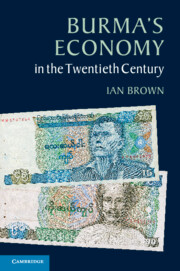Book contents
- Frontmatter
- Dedication
- Contents
- List of Illustrations
- List of Tables
- Note on names
- Acknowledgements
- Map of Burma/Myanmar
- Introduction
- 1 The economy at the beginning of the twentieth century
- 2 Strains in the late colonial economy
- 3 War and independence
- 4 In pursuit of socialism
- 5 Toward the market: the economy from 1988
- Conclusion: themes and threads
- Bibliography
- Index
- References
5 - Toward the market: the economy from 1988
Published online by Cambridge University Press: 05 June 2014
- Frontmatter
- Dedication
- Contents
- List of Illustrations
- List of Tables
- Note on names
- Acknowledgements
- Map of Burma/Myanmar
- Introduction
- 1 The economy at the beginning of the twentieth century
- 2 Strains in the late colonial economy
- 3 War and independence
- 4 In pursuit of socialism
- 5 Toward the market: the economy from 1988
- Conclusion: themes and threads
- Bibliography
- Index
- References
Summary
Reform and its limitations
In March 1989, the State Law and Order Restoration Council (SLORC), the new military government that had taken power the previous September, revoked legislation of 1965 that had established the socialist economic system. The stated ambition of the new administration, in contrast, was to secure the evolution of a market-oriented economy. A key figure in this apparently major realignment was Brigadier General David Abel, at that time Minister of Trade and Minister of National Planning and Finance, and who, in the 1990s, would be ‘the most articulate and internationally well-known spokesman for the SLORC’. But in fact the dismantling of the socialist economy had begun in the final year of BSPP rule, for, as noted in the previous chapter, on 1 September 1987 the BSPP had removed the long-established controls on domestic trade in nine agricultural commodities, including, crucially, rice.
A year later, in October 1988, the SLORC lifted the ban on the private export of agricultural commodities – although not the export of rice. The following month, the new government made it clear that, after almost three decades of near-total exclusion, Myanmar would again allow, indeed would encourage, investment by foreign private capital. The Foreign Investment Law of November 1988 made provision for full foreign ownership of concerns operating in Myanmar – it did not insist on joint ventures – with approval of investment applications from foreign interests being overseen by a Foreign Investments Commission. In the first decade, the fiscal years 1989 to 1998, over 300 FDI (foreign direct investment) applications, with a total value close to $7,200 million, were approved, principally in oil and gas exploration and extraction, hotels and tourism, manufacturing and light industry (notably garment manufacture), real estate, and construction.
- Type
- Chapter
- Information
- Burma's Economy in the Twentieth Century , pp. 176 - 202Publisher: Cambridge University PressPrint publication year: 2013



